[TOC]
注意力线索
心理学认为人通过注意力线索和非注意力线索选择注意点
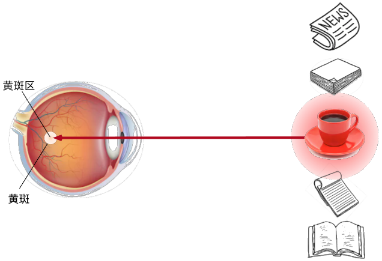
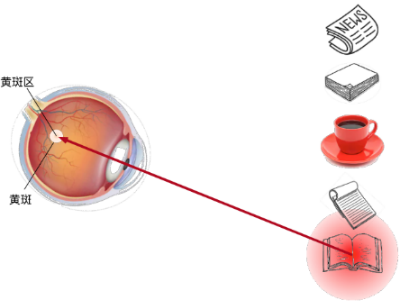
非注意力线索:将输入中最显著的特征抽取出来
注意力线索:受认知和意识的控制,根据注意力线索从输入中抽取出想要获取的特征
注意力线索与非注意力线索的表示
若想模拟非注意力线索,可以使用参数化的全连接汇聚层、卷积层,甚至是非参数的最大汇聚层或平均汇聚层
注意力机制考虑注意力线索,query(注意力线索)和key(非注意力线索)之间的交互形成了注意力汇聚
- 注意力线索称为查询(query)
- 每个输入是非注意力线索(key)和相应的值(value)
- 通过注意力汇聚层来有偏好地聚合某些输入的值(value)以生成最终输出

热力图可视化注意力线索
一般使用热力图对相关键的权重进行可视化
1
2
3
4
5
6
7
8
9
10
11
12
13
14
15
16
17
18
19
20
21
| import torch
from d2l import torch as d2l
def show_heatmaps(matrices, xlabel, ylabel, titles=None, figsize=(2.5, 2.5),cmap='Reds'):
"""显示矩阵热图"""
d2l.use_svg_display()
num_rows, num_cols = matrices.shape[0], matrices.shape[1]
fig, axes = d2l.plt.subplots(num_rows, num_cols, figsize=figsize,
sharex=True, sharey=True, squeeze=False)
for i, (row_axes, row_matrices) in enumerate(zip(axes, matrices)):
for j, (ax, matrix) in enumerate(zip(row_axes, row_matrices)):
pcm = ax.imshow(matrix.detach().numpy(), cmap=cmap)
if i == num_rows - 1:
ax.set_xlabel(xlabel)
if j == 0:
ax.set_ylabel(ylabel)
if titles:
ax.set_title(titles[j])
fig.colorbar(pcm, ax=axes, shrink=0.6);
|
1
2
3
|
attention_weights = torch.eye(10).reshape((1, 1, 10, 10))
show_heatmaps(attention_weights, xlabel='Keys', ylabel='Queries')
|
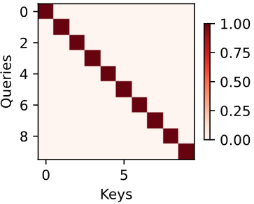
注意力线索与非注意力线索的实现
数据集
1
2
3
| import torch
from torch import nn
from d2l import torch as d2l
|
简单模拟,输入-输出 数据集为 $\{(x_1,y_1),(x_2,y_2),\cdots,(x_n,y_n)\}$ ,通过学习 $f$ 来预测任意新查询 $x$ 的输出 $\hat{y}=f(x)$
1
2
3
4
5
6
7
8
9
10
11
12
13
14
| n_train = 50
x_train, _ = torch.sort(torch.rand(n_train) * 5)
def f(x):
return 2 * torch.sin(x) + x**0.8
y_train = f(x_train) + torch.normal(0.0, 0.5, (n_train,))
x_test = torch.arange(0, 5, 0.1)
y_truth = f(x_test)
n_test = len(x_test)
|
1
2
3
4
5
6
| def plot_kernel_reg(y_hat):
d2l.plot(x_test, [y_truth, y_hat], 'x', 'y', legend=['Truth', 'Pred'],
xlim=[0, 5], ylim=[-1, 5])
d2l.plt.plot(x_train, y_train, 'o', alpha=0.5);
|
非注意力汇聚的实现
平均汇聚层可以被看做各输入权重相等的加权平均
1
2
3
4
5
6
| # torch.repeat_interleave(inputs,n_times)用于对张量中的每个元素进行重复
# in=[1,2],torch.repeat_interleave(in,2)=[1,1,2,2]
# 每个查询都输出训练集的均值
y_hat = torch.repeat_interleave(y_train.mean(), n_test)
plot_kernel_reg(y_hat)
|

非参注意力汇聚实现——Nadaraya-Watson 核回归
根据查询 query 与输入的相对位置,为每个输入的值计算权重,一般写作 $f(x)=\sum\limits_i\alpha(x,x_i)y_i$ ,其中 $\alpha(x,x_i)$ 是注意力权重
- query作为注意力线索,对环境中的非注意力线索(输入键-值对)有偏向性地生成输出
核函数 $K(\cdot)$ 是衡量查询键与被查询键距离的核函数
核函数与核函数和的比值是每个键对查询的重要性权重,所以查询的输出值是对相对重要的值加权求和
Nadaraya-Watson 高斯核回归
将高斯核代入,可得
1
2
3
4
5
6
7
8
9
10
11
|
X_repeat = x_test.repeat_interleave(n_train).reshape((-1, n_train))
attention_weights = nn.functional.softmax(-(X_repeat - x_train)**2 / 2, dim=1)
y_hat = torch.matmul(attention_weights, y_train)
plot_kernel_reg(y_hat)
|
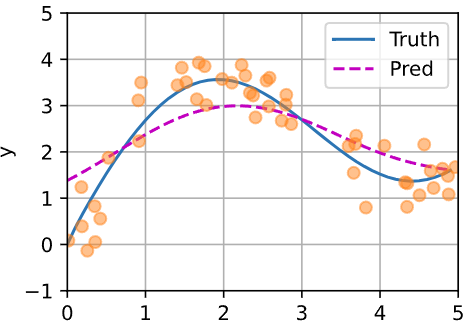
$[0,1]$ 与 $[3,4]$ 之间的数据量少,所以查询的预测输出偏移比较大,在数据密集的区间偏移较小
理论上只要有足够多的数据,就能拟合真实的曲线,但现实上没有充足的数据
非参方法的好处是不需要学习
可观察到:如果一个键 $x_i$ 越接近给定的查询 $x$ ,注意力汇聚层分配给这个键对应值 $y_i$ 的注意力权重越大
1
2
3
4
|
d2l.show_heatmaps(attention_weights.unsqueeze(0).unsqueeze(0),
xlabel='Sorted training inputs',
ylabel='Sorted testing inputs')
|

带参数注意力汇聚的实现
注意力汇聚层是根据给定的查询与不同键之间的关系计算得出
- 在训练过程中,输入 $x_i$ 作为查询 $x$ ,其他输入作为键 $\{x_j,j\neq i\}$ ,通过汇聚键相应的值 $\{y_j,j\neq i\}$ 去预测查询的值 $\hat{y}_i$ ,通过最小化损失函数更新预测器 $f$ 的权重集合,使得 $y_i$ 与 $\hat{y}_i$ 的差异最小化
- 在推理过程中,新查询 $x$ 作为输入通过 $f(x)$ 得到其预测输出
在查询 $x$ 和键 $x_i$ 之间的距离乘可学习的参数 $w$ :
训练过程,
查询 $query\in \mathbb{R}^{1\times n_train}$ ,输入的键-值 $K,V\in \mathbb{R}^{n_train\times (n_train-1)}$ ,为便于计算,将每个查询复制 $n_train-1$ 次 变形为 $queries\in \mathbb{R}^{n_train\times n_train-1}$
参数为 $\mathbf{W}\in \mathbb{R}^{n_train\times n_train-1}$
计算注意力得分 $bmm(attention_weights,V) \in \mathbb{R}^{[n_train\times 1\times (n_train-1)]\times [n_train\times (n_train-1)\times 1]}=\mathbb{R}^{n_train\times 1}$
1
2
3
4
5
6
7
8
9
10
11
12
13
14
15
|
class NWKernelRegression(nn.Module):
def __init__(self, **kwargs):
super().__init__(**kwargs)
self.w = nn.Parameter(torch.rand((1,), requires_grad=True))
def forward(self, queries, keys, values):
queries = queries.repeat_interleave(keys.shape[1]).reshape((-1, keys.shape[1]))
self.attention_weights = nn.functional.softmax(
-((queries - keys) * self.w)**2 / 2, dim=1)
return torch.bmm(self.attention_weights.unsqueeze(1),
values.unsqueeze(-1)).reshape(-1)
|
训练
1
2
3
4
5
6
7
8
9
10
11
12
13
14
|
X_tile = x_train.repeat(n_train, 1)
Y_tile = y_train.repeat(n_train, 1)
keys = X_tile[(1 - torch.eye(n_train)).type(torch.bool)].reshape((n_train, -1))
values = Y_tile[(1 - torch.eye(n_train)).type(torch.bool)].reshape((n_train, -1))
|
使用平方损失和随机梯度下降,使在训练集上的损失函数减小
1
2
3
4
5
6
7
8
9
10
11
12
| net = NWKernelRegression()
loss = nn.MSELoss(reduction='none')
trainer = torch.optim.SGD(net.parameters(), lr=0.5)
animator = d2l.Animator(xlabel='epoch', ylabel='loss', xlim=[1, 5])
for epoch in range(5):
trainer.zero_grad()
l = loss(net(x_train, keys, values), y_train)
l.sum().backward()
trainer.step()
print(f'epoch {epoch + 1}, loss {float(l.sum()):.6f}')
animator.add(epoch + 1, float(l.sum()))
|
在推理过程中
查询是 $n_test$ 个,输入的键和值都是 $n_train$ 个,相当于预测每个查询的输出是对训练集中所有输入的加权平均
1
2
3
4
5
6
|
keys = x_train.repeat(n_test, 1)
values = y_train.repeat(n_test, 1)
y_hat = net(x_test, keys, values).unsqueeze(1).detach()
plot_kernel_reg(y_hat)
|
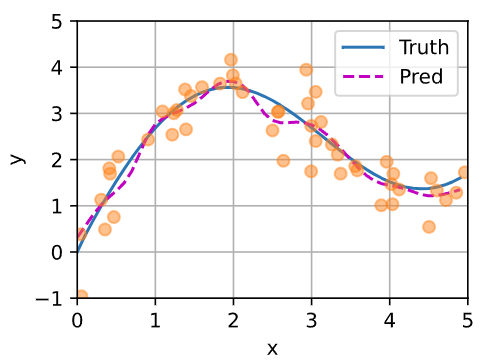
与非参数的注意力汇聚模型相比,带参数的模型加入可学习的参数后,曲线在注意力权重较大的区域变得更不平滑
数据比较少时,为了拟合数据,需要比较小的核函数窗口,所以曲线不平滑
好处:拟合效果好
坏处:噪音敏感
W使整个高斯核窗口变窄,测试时,对应的训练样本的权重分配相对集中
如图,在 0,1,2.2,5 附近,数据较少,所以对训练数据分配的权重相对集中
在 $(0,1),(1,2),(2.5,5)$ 区间内,数据较多,所以权重分配比较分散
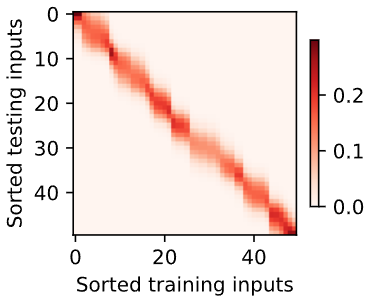
英文版内容多








